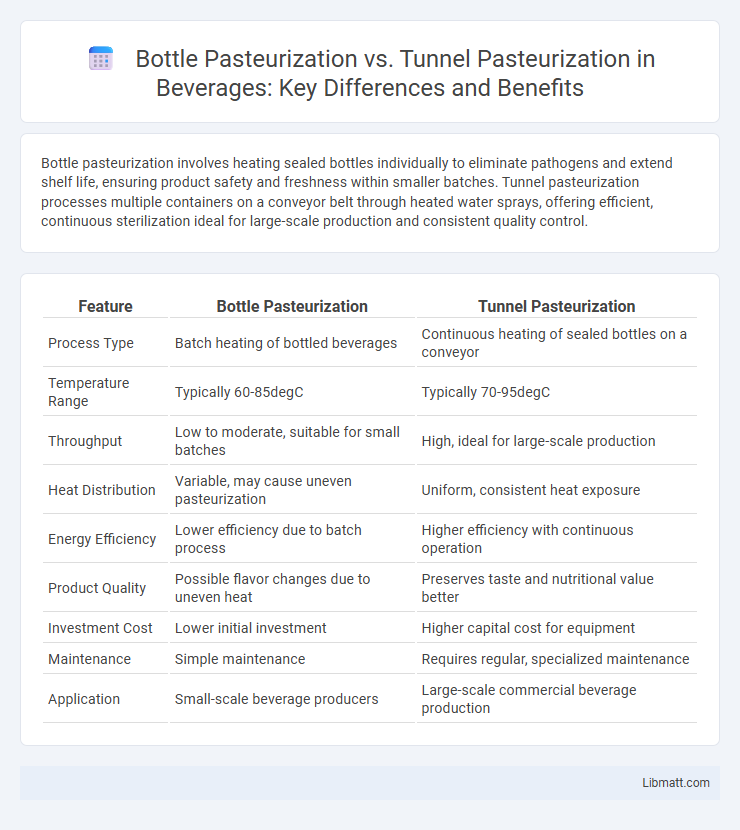Bottle pasteurization involves heating sealed bottles individually to eliminate pathogens and extend shelf life, ensuring product safety and freshness within smaller batches. Tunnel pasteurization processes multiple containers on a conveyor belt through heated water sprays, offering efficient, continuous sterilization ideal for large-scale production and consistent quality control.
Table of Comparison
| Feature | Bottle Pasteurization | Tunnel Pasteurization |
|---|---|---|
| Process Type | Batch heating of bottled beverages | Continuous heating of sealed bottles on a conveyor |
| Temperature Range | Typically 60-85degC | Typically 70-95degC |
| Throughput | Low to moderate, suitable for small batches | High, ideal for large-scale production |
| Heat Distribution | Variable, may cause uneven pasteurization | Uniform, consistent heat exposure |
| Energy Efficiency | Lower efficiency due to batch process | Higher efficiency with continuous operation |
| Product Quality | Possible flavor changes due to uneven heat | Preserves taste and nutritional value better |
| Investment Cost | Lower initial investment | Higher capital cost for equipment |
| Maintenance | Simple maintenance | Requires regular, specialized maintenance |
| Application | Small-scale beverage producers | Large-scale commercial beverage production |
Introduction to Pasteurization Methods
Bottle pasteurization involves heating filled bottles to a specific temperature to eliminate pathogens, preserving beverage quality and safety. Tunnel pasteurization processes sealed containers continuously through heated water sprays, ensuring uniform temperature exposure for large-scale production. Your choice depends on production volume, product type, and desired efficiency.
What is Bottle Pasteurization?
Bottle pasteurization is a heat treatment process designed to eliminate harmful microorganisms in beverages contained within individual bottles, ensuring product safety and extending shelf life. This method involves heating the sealed bottles to a precise temperature for a specific duration, maintaining beverage quality without altering flavor or nutritional value. Your choice of bottle pasteurization suits small batch production and artisanal beverage companies seeking controlled, uniform pasteurization for each container.
What is Tunnel Pasteurization?
Tunnel pasteurization is an industrial process where filled and sealed bottles or cans are conveyed through a temperature-controlled water or steam tunnel to achieve microbial inactivation, ensuring product safety and extended shelf life. This method provides uniform heat distribution and is suitable for large-scale beverage production, including juices, beers, and soft drinks. Compared to bottle pasteurization, tunnel pasteurization offers higher throughput and consistent pasteurization without opening the containers.
Key Differences between Bottle and Tunnel Pasteurization
Bottle pasteurization involves heating filled bottles individually or in small batches, allowing precise temperature control and preventing product degradation, suitable for limited production runs. Tunnel pasteurization processes bottles continuously on a conveyor belt through controlled water sprays, ensuring uniform heat treatment and high throughput for large-scale operations. Key differences include batch versus continuous processing, temperature uniformity, production capacity, and scalability for various beverage types.
Efficiency and Throughput Comparison
Bottle pasteurization offers precise temperature control ideal for small-scale production, but its batch processing limits efficiency and throughput compared to tunnel pasteurization. Tunnel pasteurization excels in continuous, high-volume operations, enabling faster processing rates and greater throughput with reduced labor costs. Your choice between these methods should consider production scale and efficiency demands to optimize operational performance.
Impact on Product Quality and Shelf Life
Bottle pasteurization offers precise temperature control, minimizing heat exposure and preserving delicate flavors, nutrients, and aroma compounds, which enhances overall product quality. Tunnel pasteurization provides uniform heat distribution for bulk packaging, effectively extending shelf life by reducing microbial load while maintaining consistent product safety. Both methods improve shelf life, but bottle pasteurization is preferred for premium products requiring careful quality retention.
Energy Consumption and Environmental Considerations
Bottle pasteurization typically consumes less energy per unit due to smaller batch sizes and more targeted heating, making it more environmentally friendly for lower production volumes. Tunnel pasteurization, while energy-intensive because it heats entire product trains continuously, benefits from streamlined automation and can be more efficient at large scales. Your choice between the two methods should consider production volume, energy costs, and sustainability goals to minimize environmental impact effectively.
Applicability to Different Beverage Types
Bottle pasteurization is ideal for small to medium batches of beverages such as juices, dairy products, and craft beers, providing precise temperature control to preserve flavor and nutritional content. Tunnel pasteurization suits high-volume production of carbonated drinks, bottled water, and soft drinks, enabling continuous processing with consistent heat treatment. Both methods ensure microbial safety, but selection depends on beverage type, production scale, and packaging material compatibility.
Cost Analysis: Initial Investment and Operational Costs
Bottle pasteurization requires lower initial investment compared to tunnel pasteurization due to simpler equipment and smaller scale setups. Operational costs for bottle pasteurization are higher per unit because of increased labor and slower processing times, while tunnel pasteurization benefits from economies of scale, reducing energy consumption and labor costs. Tunnel pasteurization's higher initial capital expenditure is offset over time by its efficiency and throughput, making it more cost-effective for large-scale production.
Choosing the Right Pasteurization Method for Your Production Line
Choosing the right pasteurization method for your production line depends on factors such as production volume, product type, and packaging. Bottle pasteurization is ideal for smaller batches and sensitive products requiring gentle heat treatment, ensuring flavor and nutrient retention. Tunnel pasteurization suits high-capacity lines with consistent packaging sizes, offering efficient, continuous heat treatment for extended shelf life.
Bottle pasteurization vs tunnel pasteurization Infographic

 libmatt.com
libmatt.com